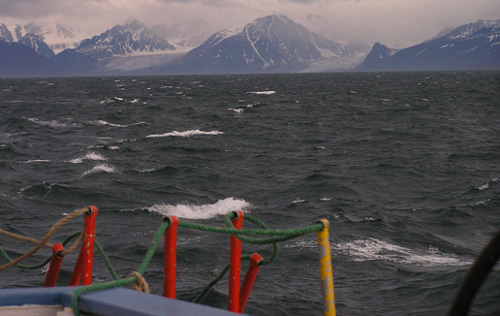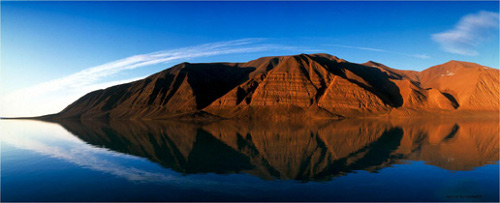As we contemplate using long-range tools like spectroscopy to examine distant exoplanets for life, we’re also developing the hands-on equipment we’ll need for seeking it out in our own Solar System. Project SLIce (Signatures of Life in Ice) is a case in point, an attempt to study how organic material behaves in ice on other worlds by using Earth settings as an analogy. On that score, the archipelago of Svalbard has proven to be a helpful testbed.
Located in the Arctic Ocean between Norway and the North Pole, Svalbard is icy and spectacular. The image below conjures up memories of a nautical journey I took around Iceland in the 1970s, with white-capped seas pushing up against snow-clad peaks. The SLIce team sees Svalbard as a laboratory for looking for extant or extinct life, and a place to develop the protocols for working with rovers in operating environments like Mars.

Image: I love Iceland, but pushing as far north as Svalbard would really bring out the adventurer in me. Here we see rough seas in the Arctic Ocean with mountains and glaciers in the distance. Credit: NASA/AMASE/Kirsten Fristad.
Here’s Liane Benning (University of Leeds) discussing the procedures under examination:
“For SLIce, we applied the protocol we had developed to take ice cores, process them and analyze them in the field just as would happen on a rover on Mars, and then of course we took them back to the lab and did a much wider range of tests, so we really knew what we had found. There could be microbes living in the ice, but there could also be the dead bodies of microbes that used to live there, and there could be biological molecules that blew in from dust and micrometeorites. We need to identify what we’ve got, so that we know what it’s telling us.”
And if that earlier image didn’t make you think of Mars, at least the non-aqueous part of the image below should. Here’s we’re looking at the Redbeds in Bockfjorden. These are layered sediments in northern Svalbard that may be similar to layered sedimentary deposits on Mars (credit: Kjell Ove Storvick/AMASE).

An early SLIce result, described at the Goldschmidt2009 geochemistry meeting in Davos last week: The best place to look for microorganisms in ice is in the layers close to the surface. That’s good to know, because a planetary rover is going to be able to sample such environments much more readily than those several meters beneath. Also helpful is the team’s discovery that cleaning the rover’s sample scoop is harder than it looks, leaving dead micro-organisms on it even after it had apparently been sterilized. New procedures have resolved the problem, ensuring we don’t inadvertently ‘discover’ Earth organisms that have found their way along for the ride.
What happens as we move further out in the Solar System? It’s interesting to speculate on the status of microorganisms near the surface in a radiation-withered environment like that of Europa. But as Richard Greenberg has convincingly demonstrated in his book Unmasking Europa (Springer, 2008), the movement of ice on that world should bring material to the surface — search in the right place and life’s remnants may be close at hand. Now all we have to do is find the funding for a Europa lander (which may be harder to do than flying the mission itself), while developing sufficient radiation shielding to make it feasible. Astrobiology offers no shortage of challenges.


ah, yes… but what is “life”? ours is surely not the only form. unless we observed it “living” we might not recognize it.
Hi Folks;
Ice is an excellent place to look for microbial and other simple life forms.
The professor of my undergraduate thermal physics course about about a 1 1/2 decades ago use to mention someone who was at that point, the world’s leading expert on ice and how there were literally dozens of different forms of water ice. Now this person’s knowledge of ice is of no credit to me since I never met him and the only experience I have with ice is little beyond storing ice in my home freezer, I still think it is a great topic.
However, given the wide range of forms of ice as such, there is plenty of ice chemistry to consider when it comes to studying how ice environments might support or hold records of previous organisms on other planetary bodies in our solar system, including icy bodies within the Kuiper Belt and Oort Cloud, and hopefully on nearby extrasolar planetary bodies.
For all the opportuinities that the study of ice and any associated life it presents, ice is not only cold, but it is COOL!
considering the confirmed existence of exoplanets, and the fact that life on earth developed from common elements, i believe that there is life elsewhere in the universe. if we find that life evolved independently on other bodies in our solar system, that would suggest that life is common, or at least more common than we thought.
on another note, it would be an interesting legacy (but undesireable?) for us to spread our own life to other planets/moons.
I think it would be a sad day indeed if life (even one microbe) were to be discovered on/within Sol’s satalites and the scientific or political powers that be, decided to not colonize any satalite in our solar system for fear of harming it, and by extension the Centauri system as well.
A galaxy full of life and humanity forever self imprisoned because of it, are for me the stuff of nightmares.
I hope that life is found, and my nightmares are unfulfilled.
Ice is pretty incredible. All its phases – up to Ice XV according to recent work – are different, puzzling and often difficult to study – one version of Ice X, for example, is only found at a million bars of pressure or so. Such Red-Hot ice probably makes up large parts of Neptune and Uranus.
I’m hopeful about life on Europa. Less so Enceladus or Titan. But who knows? We’d die of boredom if Life = DNA-RNA biochemistry alone.
Hi Blade O’ grass;
I could not agree with you more.
Assuming that one out of every 10 Earthed mass planets in our galaxy is habitable or terraformable, perhaps 100 billion planets are available for humanity to colonize just within the Milky Way alone assumming on average one out of every few stars has a solar system simillar to ours. Given optimal renewable energy and sustainable industrial practices, each such planet might support up to 100 billion persons, or at the very least 10 billion, a population that Earth will nearly approach by 2050. As a result, as much as (10 EXP 11)(10 EXP 11) or 10 EXP 22 human persons might live simultaneously within the Milky Way. Over the stellerferus lifetime of our galaxy of about 10 EXP 14 years and assumming that human life expectancy will oneday approach 1,000 years, that is 10 EXP [22 + (14 – 3)] persons or 10 EXP 33 persons that will have lived. If one extrapolates these figures for the perhaps 10 EXP 22 habitable or terraformable planets within the observable univere, the figure grows 10 EXP (33 + 11) = 10 EXP 44.
As a middle aged single guy, the thought of half as many unique physically beautiful female genotypes and equally distinct beautiful female minds and hearts is very intreguing. Grins and Giggles! But more seriously, as the cosmos has gone through several phase chamges such as the symmetry breaking events that have lead to the separation of the four known forces, and also the photon-plasma decoupling at a CMBR temperature of about 3,000 K, perhaps the wide spread existence of intellegent life such as human life and/or any ETI life can be viewed as another phase change within the cosmos.
I would not be surprised if our solar system can and eventually does support 1 trillion humans given the potential opportuinities to set up shop on the moon, Mars, perhaps a terraformed Venus, and perhaps some of the many proposed icy worlds in the Kuiper Belt and Oort Cloud.
In a way, human and any ETI life is just as fundamental of a type macroscopic structure as stars, galaxies, comets, asteroids, and black holes are as can be seen from all of the objective and subjective aspects of human life, both in terms of our physical organism and our interior psychodynamic aspects that collectively we define as unique human persons.
If indeed, ETI life is ubiquitous among the galaxies, in a myriad of species, we will no doubt have to respect the integrity of such lifeforms and civilizations, but in such a case, all of us can contemplate a certain sense of meaning or purpose in the cosmos as it would then be all but shown to be oriented for or atleast to the development of intellegent and sentient life..
I may have overestimated the numbers of persons a given planet can support, but going completely green, low per capita impact, and sustainable on Earth may be the best testing ground for the above proposed numbers. This is partly why I jumped on the green and clean bandwagon about 10 years ago when my brother John and I started the process of our inventive work within the field of low cost green renewable energy technologies that are very simple.
Blade O’grass
There is most probably no macroscopic life there, and bacteria are almost indestructible. There is no way earth life could hurt them. Even the most ambitious terraforming project would be geologically slow for them. They would simply adapt to new, and richer environment without any problem.
I think the major obstacles to extraterrestrial colonisation will be that it is extremely difficult to get to the destination, the destinations near enough to contemplate visiting are lethally uninhabitable (same goes for the vast majority of destinations even beyond what we can contemplate visiting), and that there’s not much benefit to those who are left behind for the large economic expenditure involved. It’s easy to talk of space colonisation, but without invoking magic fantasy-tech, the engineering is considerably harder…
The problem is not bacterial life which tends to be durable and adaptable, but its more complex counterpart. We can easily destroy complex life before we realize what it is — even by neutral observation. For example, it took special instruments to discover the thriving communities of fragile, gelatinous animals living in the ocean depths: the conventional methods originally used to capture samples shredded them to confetti.
This issue has come up even with the Viking probes. I briefly wrote about it here:You Only Find What You’re Looking For
Arctic bugs may have the longest life-cycle on Earth
15:34 21 September 2010 by Lewis Dartnell
WITH a hibernation period of up to 100 million years, bacteria discovered on the Arctic sea floor may have longest life cycle of any known organism.
Casey Hubert from the Geosciences Group at Newcastle University, UK, and colleagues came across the bacteria while studying biological activity in sediment samples from the sea floor off the Norwegian island of Svalbard.
What the team expected to find were organisms that flourish in the cold, but are killed at higher temperatures.
Full article here:
http://www.newscientist.com/article/dn19475-arctic-bugs-may-have-the-longest-lifecycle-on-earth.html